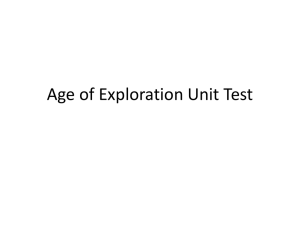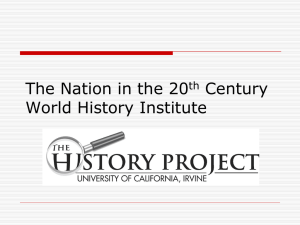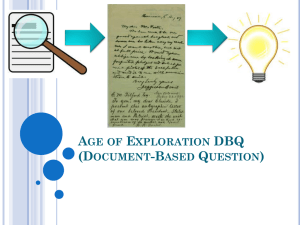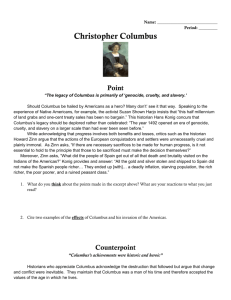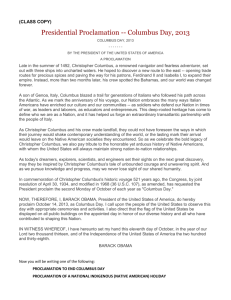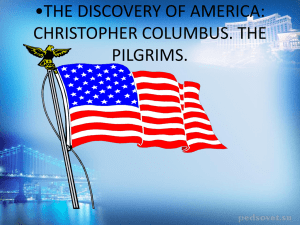The Columbus Story - Central Bucks School District
advertisement
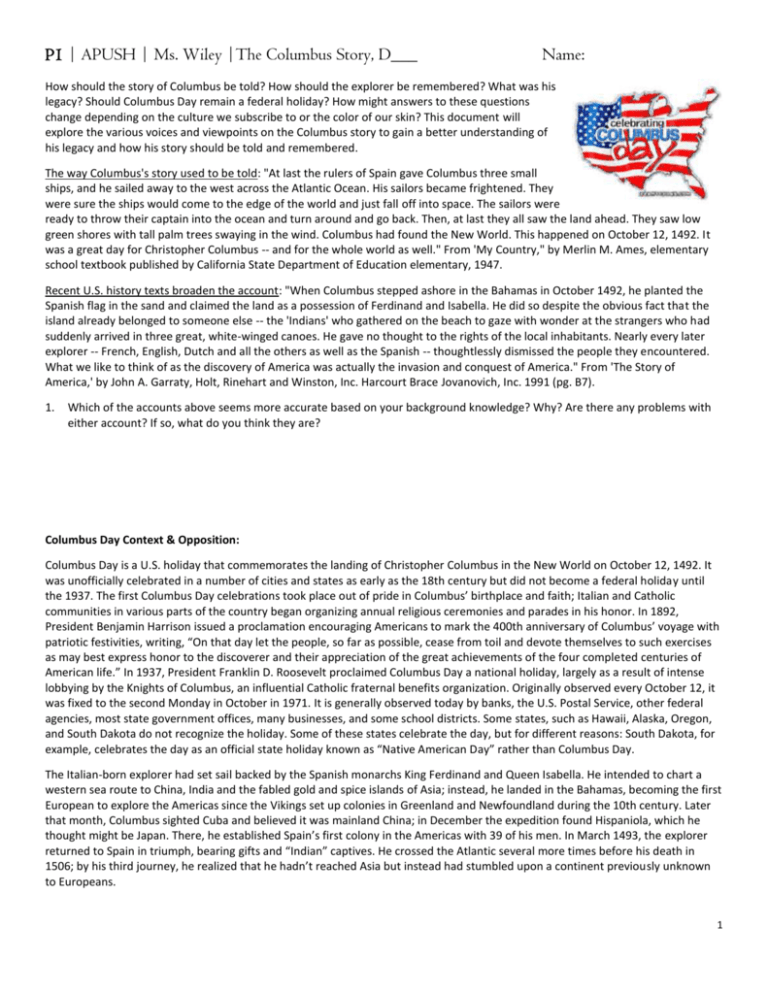
P1 | APUSH | Ms. Wiley |The Columbus Story, D___ Name: How should the story of Columbus be told? How should the explorer be remembered? What was his legacy? Should Columbus Day remain a federal holiday? How might answers to these questions change depending on the culture we subscribe to or the color of our skin? This document will explore the various voices and viewpoints on the Columbus story to gain a better understanding of his legacy and how his story should be told and remembered. The way Columbus's story used to be told: "At last the rulers of Spain gave Columbus three small ships, and he sailed away to the west across the Atlantic Ocean. His sailors became frightened. They were sure the ships would come to the edge of the world and just fall off into space. The sailors were ready to throw their captain into the ocean and turn around and go back. Then, at last they all saw the land ahead. They saw low green shores with tall palm trees swaying in the wind. Columbus had found the New World. This happened on October 12, 1492. It was a great day for Christopher Columbus -- and for the whole world as well." From 'My Country," by Merlin M. Ames, elementary school textbook published by California State Department of Education elementary, 1947. Recent U.S. history texts broaden the account: "When Columbus stepped ashore in the Bahamas in October 1492, he planted the Spanish flag in the sand and claimed the land as a possession of Ferdinand and Isabella. He did so despite the obvious fact that the island already belonged to someone else -- the 'Indians' who gathered on the beach to gaze with wonder at the strangers who had suddenly arrived in three great, white-winged canoes. He gave no thought to the rights of the local inhabitants. Nearly every later explorer -- French, English, Dutch and all the others as well as the Spanish -- thoughtlessly dismissed the people they encountered. What we like to think of as the discovery of America was actually the invasion and conquest of America." From 'The Story of America,' by John A. Garraty, Holt, Rinehart and Winston, Inc. Harcourt Brace Jovanovich, Inc. 1991 (pg. B7). 1. Which of the accounts above seems more accurate based on your background knowledge? Why? Are there any problems with either account? If so, what do you think they are? Columbus Day Context & Opposition: Columbus Day is a U.S. holiday that commemorates the landing of Christopher Columbus in the New World on October 12, 1492. It was unofficially celebrated in a number of cities and states as early as the 18th century but did not become a federal holiday until the 1937. The first Columbus Day celebrations took place out of pride in Columbus’ birthplace and faith; Italian and Catholic communities in various parts of the country began organizing annual religious ceremonies and parades in his honor. In 1892, President Benjamin Harrison issued a proclamation encouraging Americans to mark the 400th anniversary of Columbus’ voyage with patriotic festivities, writing, “On that day let the people, so far as possible, cease from toil and devote themselves to such exercises as may best express honor to the discoverer and their appreciation of the great achievements of the four completed centuries of American life.” In 1937, President Franklin D. Roosevelt proclaimed Columbus Day a national holiday, largely as a result of intense lobbying by the Knights of Columbus, an influential Catholic fraternal benefits organization. Originally observed every October 12, it was fixed to the second Monday in October in 1971. It is generally observed today by banks, the U.S. Postal Service, other federal agencies, most state government offices, many businesses, and some school districts. Some states, such as Hawaii, Alaska, Oregon, and South Dakota do not recognize the holiday. Some of these states celebrate the day, but for different reasons: South Dakota, for example, celebrates the day as an official state holiday known as “Native American Day” rather than Columbus Day. The Italian-born explorer had set sail backed by the Spanish monarchs King Ferdinand and Queen Isabella. He intended to chart a western sea route to China, India and the fabled gold and spice islands of Asia; instead, he landed in the Bahamas, becoming the first European to explore the Americas since the Vikings set up colonies in Greenland and Newfoundland during the 10th century. Later that month, Columbus sighted Cuba and believed it was mainland China; in December the expedition found Hispaniola, which he thought might be Japan. There, he established Spain’s first colony in the Americas with 39 of his men. In March 1493, the explorer returned to Spain in triumph, bearing gifts and “Indian” captives. He crossed the Atlantic several more times before his death in 1506; by his third journey, he realized that he hadn’t reached Asia but instead had stumbled upon a continent previously unknown to Europeans. 1 2. Should it “matter” that Columbus mistook the islands he landed on as parts of Asia? Does this necessarily make his story/legacy less of an achievement? Why or why not? Opposition to Columbus Day dates to at least the 19th century where activists had sought to eradicate Columbus Day celebrations because of its association with immigrants and the Knights of Columbus. They were afraid it was being used to expand Catholic influence. By far the more common opposition today, decrying Columbus's and Europeans' actions against the indigenous populations of the Americas, did not gain much traction until the latter half of the 20th century. There are two main strands of this critique, which are interrelated. The first refers primarily to the indigenous population collapse and cruel treatment towards indigenous peoples during the European colonization of the American continents which followed Columbus's discovery. Some, such as the American Indian Movement, have argued that the responsibility of contemporary governments and their citizens for allegedly ongoing acts of genocide against Native Americans are masked by positive Columbus myths and celebrations. These critics argue that a particular understanding of the legacy of Columbus has been used to legitimize their actions, and it is this misuse of history that must be exposed. American Indian Movement of Colorado leader and activist Ward Churchill takes this argument further, contending that the mythologizing and celebration of the European settlement of the Americas in Columbus Day make it easier for people today to avoid taking responsibility for their own actions, or the actions of their governments regarding indigenous populations. He wrote in his book Bringing the Law Back Home: Very high on the list of those expressions of non-indigenous sensibility [that] contribute to the perpetuation of genocidal policies against [American] Indians are the annual Columbus Day celebration, events in which it is baldly asserted that the process, events, and circumstances described above are, at best, either acceptable or unimportant. More often, the sentiments expressed by the participants are, quite frankly, that the fate of Native America embodied in Columbus and the Columbian legacy is a matter to be openly and enthusiastically applauded as an unrivaled "boon to all mankind". Undeniably, the situation of American Indians will not — in fact cannot — change for the better so long as such attitudes are deemed socially acceptable by the mainstream populace. Hence, such celebrations as Columbus Day must be stopped. 3. Summarize the first strand of Columbus Day opposition. A second strain of the criticism of Columbus Day focuses on the character of Columbus himself. In time for the observation of Columbus Day in 2004, the final volume of a compendium of Columbus-era documents was published by the University of California, Los Angeles's Medieval and Renaissance Center. Geoffrey Symcox, the general editor of the project, asserted: "While giving the brilliant mariner his due, the collection portrays Columbus as an unrelenting social climber and self-promoter who stopped at nothing— not even exploitation, slavery, or twisting Biblical scripture— to advance his ambitions… Many of the unflattering documents have been known for the last century or more, but nobody paid much attention to them until recently… The fact that Columbus brought slavery, enormous exploitation or devastating diseases to the Americas used to be seen as a minor detail – if it was recognized at all – in light of his role as the great bringer of white man's civilization to the benighted idolatrous American continent. But to historians today this information is very important. It changes our whole view of the enterprise". Historian Howard Zinn described some of the details of how Columbus personally ordered the enslavement and mutilation of the native Arawak people in a bid to repay his investors: Now, from his base on Haiti, Columbus sent expedition after expedition into the interior. They found no gold fields, but had to fill up the ships returning to Spain with some kind of dividend. In the year 1495, they went on a great slave raid, rounded up fifteen hundred Arawak men, women, and children, put them in pens guarded by Spaniards and dogs, then picked the five hundred best specimens to load onto ships. Of those five hundred, two hundred died en route. The rest arrived alive in Spain and were put up for sale by the archdeacon of the town, who reported that, although the slaves were "naked as the day they were born," they showed "no more embarrassment than animals." Columbus later wrote: "Let us in the name of the Holy Trinity go on sending all the slaves that can be sold." 2 But too many of the slaves died in captivity. And so Columbus, desperate to pay back dividends to those who had invested, had to make good his promise to fill the ships with gold. In the province of Cicao on Haiti, where he and his men imagined huge gold fields to exist, they ordered all persons fourteen years or older to collect a certain quantity of gold every three months. When they brought it, they were given copper tokens to hang around their necks. American Indians found without a copper token had their hands cut off and bled to death. 4. Summarize the second strand of Columbus Day opposition: The most important contemporary documentary evidence is the multi-volume History of the Indies by the Catholic priest Bartolomé de las Casas who observed the region where Columbus was governor. Las Casas describes Spaniards driven by "insatiable greed" — "killing, terrorizing, afflicting, and torturing the native peoples" with "the strangest and most varied new methods of cruelty" and how systematic violence was aimed at preventing "[American] Indians from daring to think of themselves as human beings." The Spaniards "thought nothing of knifing [American] Indians by tens and twenties and of cutting slices off them to test the sharpness of their blades", wrote Las Casas. "My eyes have seen these acts so foreign to human nature, and now I tremble as I write". In the summer of 1990, 350 representatives from American Indian groups from all over the hemisphere, met in Quito, Ecuador, at the first Intercontinental Gathering of Indigenous People in the Americas, to mobilize against the quincentennial celebration of Columbus Day. The following summer, in Davis, California, more than a hundred Native Americans gathered for a follow-up meeting to the Quito conference. They declared October 12, 1992, "International Day of Solidarity with Indigenous People". The largest ecumenical body in the United States, the National Council of Churches, called on Christians to refrain from celebrating the Columbus quincentennial, saying, "What represented newness of freedom, hope, and opportunity for some was the occasion for oppression, degradation and genocide for others". Writer Washington Irving's A History of the Life and Voyages of Christopher Columbus, published in 1828, is the source of much of the glorification and myth-making related to Columbus today and is considered highly fictionalized. For example, Irving's portrayal of Columbus is of a benevolent, adventurous man who was known for his generosity to Indians. In the best-seller, Columbus "was extremely desirous of dispelling any terror or distrust that might have been awakened in the island by the pursuit of the fugitives," after the escape of a group of Indian captives. This, of course, is likely the complete opposite of Columbus' actual behavior toward native people. (Incidentally, A History of the Life was also responsible for the incorrect belief that most people thought the Earth was flat until after Columbus's journey.) 5. How can we prevent erroneous “history books” from being written? Can you think of any events of people in more recent history that have perhaps been glorified and improperly represented in the media/print culture? Another question to consider: how did a man who never set foot on North America get a federal holiday in his name? While Columbus did arrive in the "New World" when he cast anchor in the Bahamas, he never made it to the United States. This is in contrast to Juan Ponce de Leon (who arrived in Florida in 1513), Alonso Alvarez de Pineda (whose ships arrived in what's now known as Corpus Christi Bay in Texas in 1519) and fellow Italian Giovanni da Verrazzano, who reached New York Harbor in 1524. Schools Growing Harsher In Scrutiny of Columbus, by Sam Dillon, October 12, 1992, The New York Times Even at Christopher Columbus High School in the Bronx, where the choir still sings the Italian national anthem at gatherings, the Great Navigator is under revisionist siege (revisionist refers to the advocacy of the revision of an accepted, usually long-standing view, theory, or doctrine, especially a revision of historical events and movements). Though Columbus's bust still gazes proudly from a school pedestal, in its classrooms he is a tarnished figure who blundered into the New World and made a hash of its exploration. Compared with that at many schools, though, the treatment is fairly generous. 3 On the 500th anniversary of his landfall in the New World, students across New York and the nation are learning everything from skepticism to contempt for the explorer's exploits. At a Brooklyn high school last week, a 17-year-old debater pilloried Columbus as a pitiful fraud who cheated his sailors and lied about his discoveries. Fourth-grade students at a private school in Greenwich Village rehearsed a play mocking Columbus as a bewildered fool obsessed by gold. In Scarsdale, N.Y., a jury of seventh-grade students voted 4-1 to declare Columbus a villain after a mock trial. One history book popular this year in some area high schools portrays Columbus as a Renaissance Darth Vader who ushered in five centuries of imperialism by enslaving, raping and butchering the native Caribs who greeted his 1492 voyage. "With Columbus, revisionism has carried the day," said Gilbert Sewall, director of the American Textbook Council, a New York-based group that reviews educational curricula. "Columbus has undergone what is perhaps the most dramatic reworking of any major historical figure in memory." The assault on Columbus began [as far back as] the 1970's, Mr. Sewall said, with new scholarship partly motivated by mounting interest in multicultural thinking. . . . [But] attacks have ignited a reaction from some indignant Columbian loyalists. One of the most vocal is William E. Simon, the former Treasury Secretary, who is scheduled to deliver a speech today at Adelphi University on Long Island. The speech is billed as a counter to the "Columbus bashing in the news today." "The arrival of this glorious anniversary in the greatest democracy in the history of the world finds Columbus under siege and America divided," Mr. Simon said in an advance text of the speech. According to the revisionists, Columbus "was a villain, a kind of seagoing Genghis Khan," Mr. Simon said in the speech. But "Columbus was above all a man of deep faith. . . . He changed the fate of the whole world forever. And he changed it for the better." Adelphi's president, Peter Diamandopoulos, who invited Mr. Simon to deliver the address, said that Columbus remains "the hero of all heroes," despite his failings. The loyalists appear to be losing ground, however. Tonya Frichner, an Onandaga Indian lawyer who addressed 750 elementary and high school students on Friday at Aaron Davis Hall in Harlem about Columbus's often brutal treatment of Indians, said she had been encouraged by the acceptance she found for her critical views during months of lecturing. Textbooks have played an important role in the changing perceptions. Daniel Boorstin's 1986 "History of the United States" -- one of the more traditional of the mass market high school texts, Mr. Sewall said, refers to Columbus as a "true leader," but also notes that Native Americans suffered after Columbus's landfall. "For some it meant the end of their Native American civilization," the book says. "For some it meant slavery. For nearly all of them Europeans brought shock, disease and change." At the other end of the spectrum is "Columbus: His Enterprise -- Exploding the Myth," by Hans Koning, a Dutch-born novelist. The book, which has been assigned to students at several schools in the New York region, calls Columbus's first Atlantic crossing a "drama of the murderer coming ever closer to his victims." Columbus and his men seized Caribbean women as "sex slaves," sent attack dogs to maul naked Indians, and disemboweled other natives who resisted conquest, the book says. During Columbus's second voyage, the book reports, Columbus rounded up 1,500 Arawak Indians and shipped 500 to Spain, where 300 were sold into slavery. The other 200 died along the way, according to the book, which is published by the Monthly Review Press. . . . Stephanie Betancourt, a Seneca Indian who is a coordinator of the [Native American Education] program, said: "For Native Americans, every Columbus Day is like salt in our wounds. These are days of mourning." The Koning text was also required reading at Polytechnic Preparatory Country Day School in the Bay Ridge section of Brooklyn. Teachers, hoping to force students into developing their critical skills by analyzing a controversial text, urged students to read the book with a skeptical eye. But its lurid passages provided seniors with plenty of ammunition for anti-Columbus barrages during a debate on Friday. "Columbus the great navigator wanted to go to India, landed near Cuba and mistook it for Japan," jeered Larksham Guttikonda, a 17-year-old senior. Later Stephane Clare, the captain of the school's debate team, assumed Columbus's ticklish defense to the hoots of a rowdy crowd. "No one is saying that Columbus did not commit atrocities," Miss Clare answered. "It might be frightening, but he was an example of everything that is the American ideal. He was an adventurer, he was an explorer, he was a breaker of new ground." After the debate Miss Clare said, "We shouldn't be putting our 1992 moral judgments on Columbus. He should be taught as a great man who committed atrocities." At the Middle School in Scarsdale, a retelling of those atrocities tipped the scales against Columbus during a "teach-in" last week. Some students argued that Columbus had shown courage in his explorations, said Len Tallevi, the head of the school's social studies department. But after "students brought out that some Indians were hanged and burned alive," a seventh-grade jury convicted the explorer as a villain, Mr. Tallevi said. At the privately run Little Red Schoolhouse in Greenwich Village, 9-year-old Carlos Heim played Columbus in a class skit last week written by a parent. "We need gold!" Carlos shouted during a rehearsal. "Find us more gold! I have claimed this land for the profit 4 and glory of Spain!" Other fourth-grade actors, playing Indians, shouted back at Columbus: "We already had languages, ideas and religions. We did not ask for new ones." Despite the revisionist wave, Columbus's heroism remains a central theme in some schools, and students like 11-year-old Simone Mazyack, who attends Public School 125 in Harlem and is of Jamaican and Puerto Rican descent, still speak with old-fashioned admiration for the explorer. "If Columbus hadn't made the sail," she said, "there wouldn't be this many buildings, because the Indians wouldn't have this much technology and it would still be mostly grass." But Simone's sixth-grade teacher, Cathy Connors, urged her class to consider African contributions to the New World by having them read from a book, "They Came Before Columbus," written by a black scholar, Ivan Van Sertima. The book argues that African navigators sailed to the Caribbean before Columbus [and other explorers, African or not, would have made Columbus’s “discovery” shortly after 1492, had he not]. At Christopher Columbus High School, the re-evaluation of its namesake has been fueled by increased ethnic diversity in the student body. The school got its name at its 1939 inaugural, when Fiorello H. La Guardia was Mayor and the school's Pelham Parkway neighborhood was overwhelmingly Italian and Jewish. Today its 3,604 students are 42 percent Hispanic, 22 percent black, and 10 percent Asian. Howard Feldman, assistant principal for social studies, said the school's teaching had moved away from a "Eurocentric" view of its namesake, with increased emphasis on the cultures the 15th-century intruders smashed [along with European studies]. 6. Devise one strong comprehension question (a question that can be answered with a close read of the text) based on The New York Times article above and briefly record the answer. 7. Record your reaction to the article: Christopher Columbus and His Legacy, Opposing Viewpoints Viewpoint 1: Viewpoint 2: Viewpoint 3: Modern Attacks on Columbus Modern Attacks on Columbus Are History Should Continue to Acknowledge Are Unwarranted Justified / History Should Acknowledge Columbus as a Discoverer Columbus as a Ruthless Exploiter 5 6
